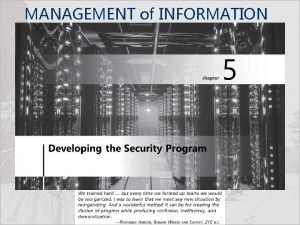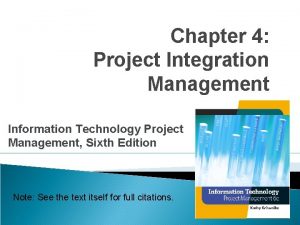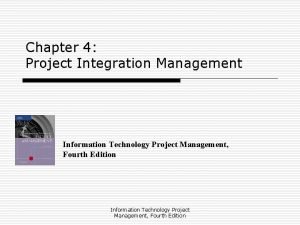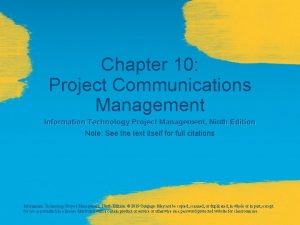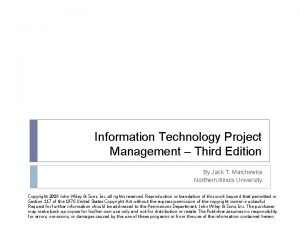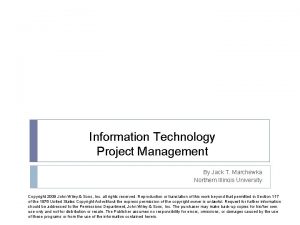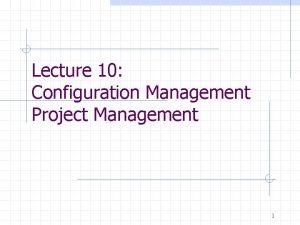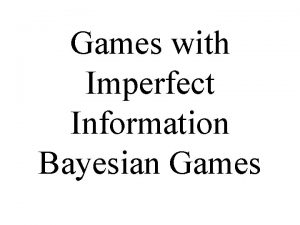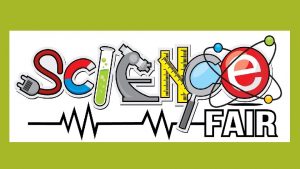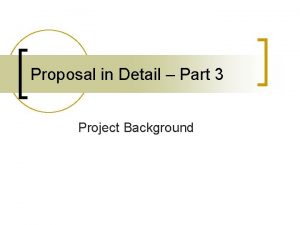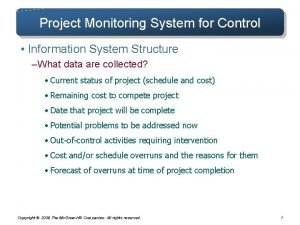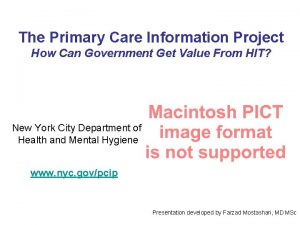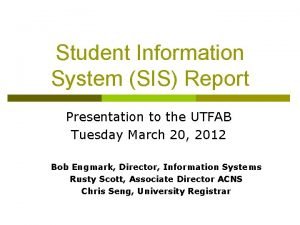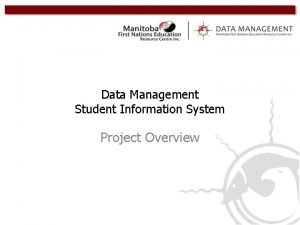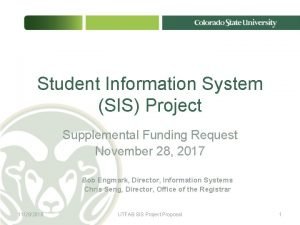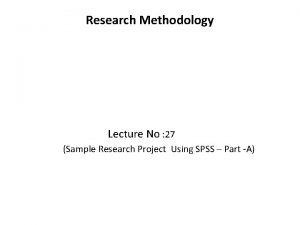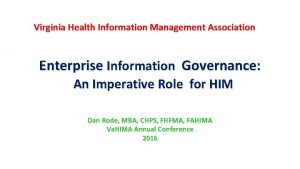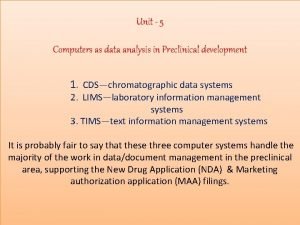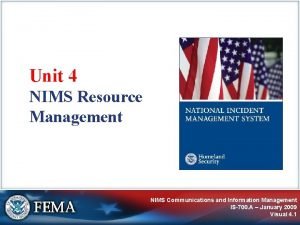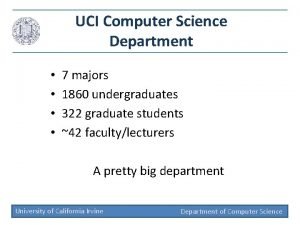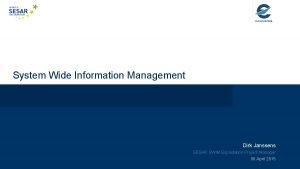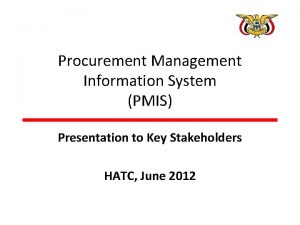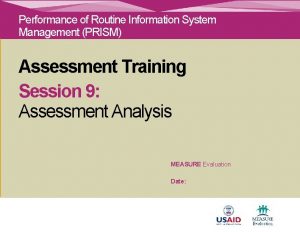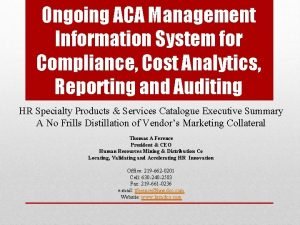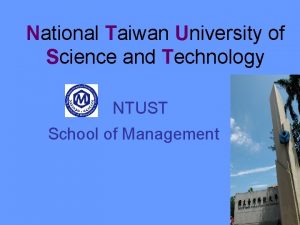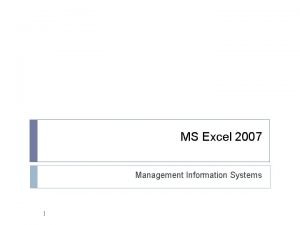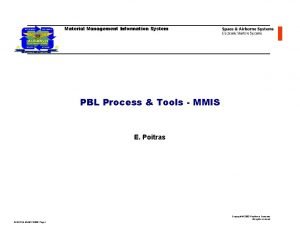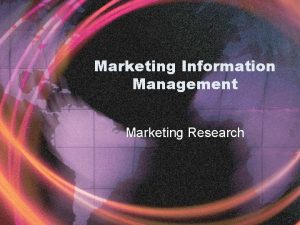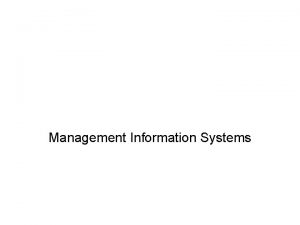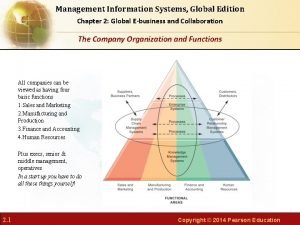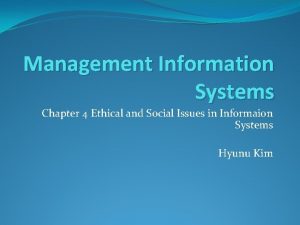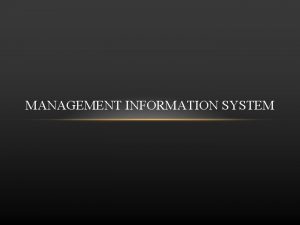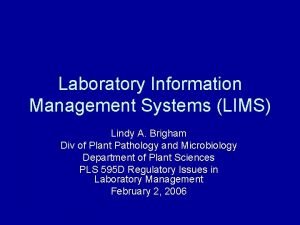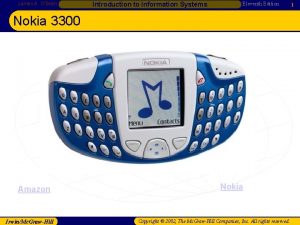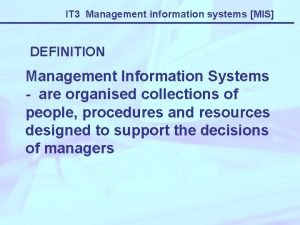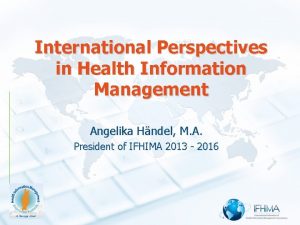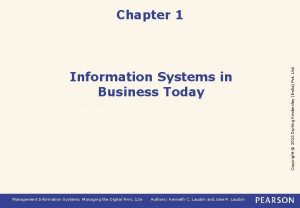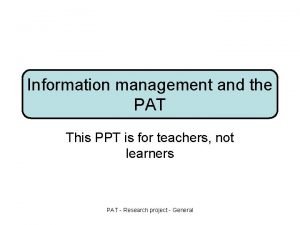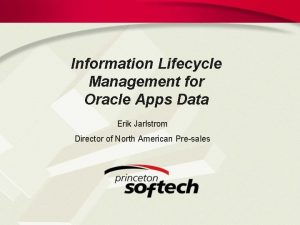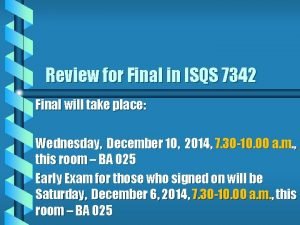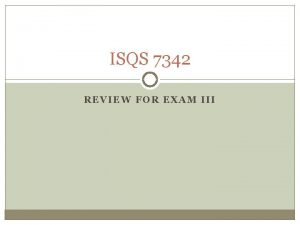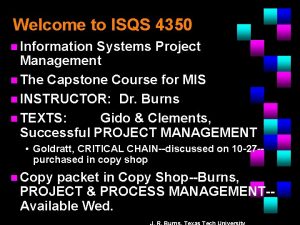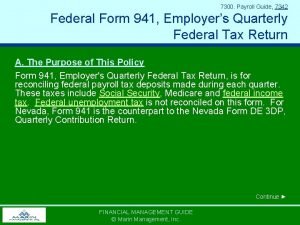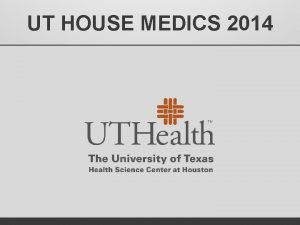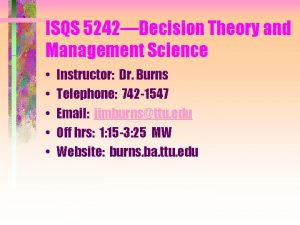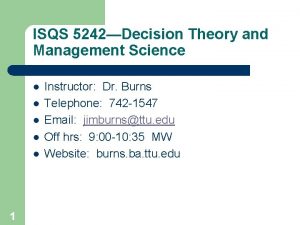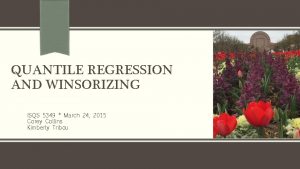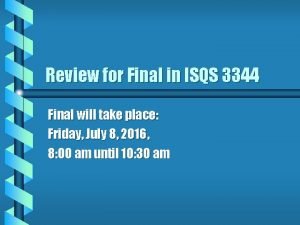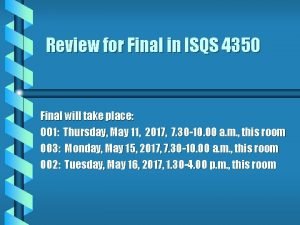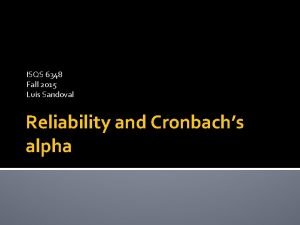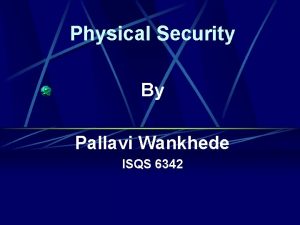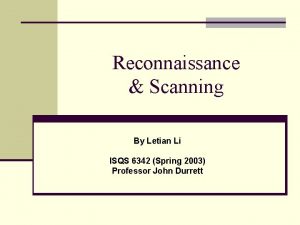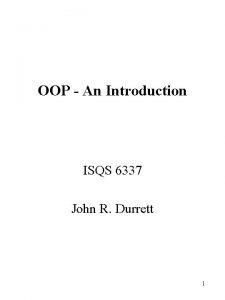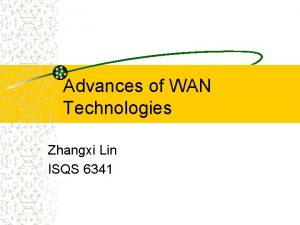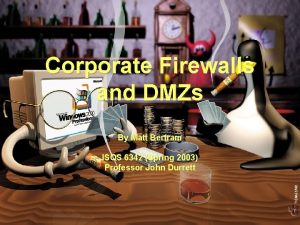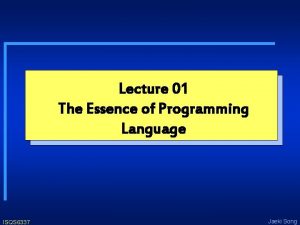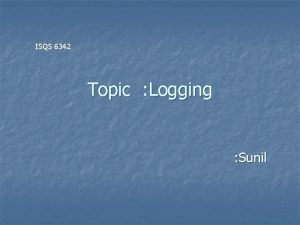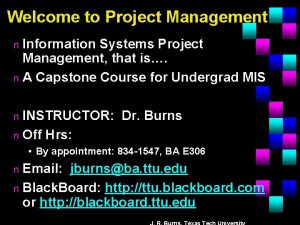Welcome to Project Management ISQS 7342 n Information






































































- Slides: 70

Welcome to Project Management ISQS 7342 n Information Systems Project Management, that is…. n INSTRUCTOR: Dr. Burns n Off Hrs: • By appointment: 834 -1547, BA E 306 n Email: jburns@ba. ttu. edu

TEXTS & REFERENCES: n Larson & Gray, Project Management: the managerial process, Fifth Edition, 2011. Burns, Project and Process Management (will be handed out one chapter at a time) 2012 -2013 REFERENCE n Goldratt, Critical Chain, 1997 n Schwalbe, Information Technology Project Management, 2014, Seventh Edition n

Outline for Today n Objectives n Requirements for Completion n Jobs n Term Project n Burns--Chapter 1

Objectives n Present technology of Project Management • Companies have organized around processes and projects, eliminating jobs • MIS Advisory Board has mandated this course Present contemporary topics n Focus on systems (processes) n Focus on best practices n Focus on rapid completion times n Objectives are listed on front page of your syllabus (today’s handout) n

Introduction of Lecturer n Taught the course for more than twenty years, from a half dozen different texts n Participated in several projects over many years as both project professional and project manager n Written many papers about Project Management n An active area of writing and research interest

Requirements for Completion n Three EXAMS and a FINAL, each worth 13% n Mid-semester report, worth 7% n Term Project, worth 21% n Homework, worth 10% n Class participation, worth 10%

GRADING n 90 -100 -- A n 80 -89. 9999 --B n 70 -79. 9999 --C n 97. 5 – up -- A+ n 92. 5 - 97. 5 -- A n 90 – 92. 5 – An Similarly for • B and C

My Expectations of You n Attend class—attendance is noted n Perform reading assignments before coming to class three n Do most work in teams—of • Homework, mid semester report and exams will be completed individually n Tech policy for academic honesty enforced n Assistance for Disabled students

You may want to JOIN AITP stands for American Association of Information Technology Professionals n Application forms are in BA E 310, the ISQS Office and online at //aitp. ba. ttu. edu n Its important to affiliate yourself with a professional organization n Dues for the first few years are cheap if you join as a student n Discounts on airlines and hotels n Low interest credit card n It’s the way MIS (and other) majors market themselves to recruiters. n

Will you be interviewing this semester? ? All students can self-register themselves at www. rawlscmc. ba. ttu. edu, by clicking on the Rawls. CONNECT logo, and then on Students. n Next, create a resume and upload it onto Rawls. CONNECT. n Take advantage of the opportunities that are coming up in the CMC through researching the companies coming to campus and preparing yourselves for interviews with them. n

Course Deliverables—Page 6 -8 of your syllabus n Preliminary proposal (one-page description) due 9 -4 • This will not be graded • You must have your teams formed and your project topic decided upon to submit this Requirements Document due 9 -23 n Project Plan due 11 -1 n Proposal due 11 -13 -13 n Mid-semester Report due 11 -18 -13 n • Won’t be included in your final term project report • Done individually—not in teams

More Course Deliverables n Earned Value Analysis due 11 -22 -13 n. Final Project due 12 -4 -13 Possible Topics are discussed in Handout n Format/Grading is discussed in Handout n

Project Topics n Taken from past employment involvements n Taken from current involvements n Based on a prototypical contemporary initiative

Term Project Protocol n Performed in groups of three, roughly n You get to choose topic n Will require a presentation beginning 11 -22 and concluding on 12 -4

Project Expectations Doesn’t have to be actually performed to completion n Must be completely planned in detail, however n • completely Scheduled • completely Resourced • completely Budgeted, costed Must include Preliminary (one page) and formal proposals as appendices n Must include all course deliverables as appendices except the midterm report n Must consist of at least 60 steps (tasks) n

Project Format Title Page n Executive Summary n Body n • • Description of the Problem Goal and Success Criteria Assumptions/Risks Recommended prescriptive Software Solution Impediments/Obstacles Current Status Lessons Learned 8 -page minimum for the material above n Bibliography n Appendices n

Appendices n Requirements Document • Revised • Old (with grade sheet and a description of revisions) n Project Plan • Revised • Old (with grade sheet and a description of revisions) n FORMAL PROPOSAL • Revised • Old (with grade sheet and a description of revisions) n Earned Value Analysis • Revised • Old (with grade sheet and a description of revisions) n See Chapter 11 of the copy packet for more details as to format

Questions n About course requirements n About project n About exams n About homework

What? Contemporary Topics!!? ? $ Internet Development n XML/Visual Interdev Projects n Lean-Agile Project Management n Systems Thinking/Integration n Process Improvement, Innovation, Reengineering n Process Impediment Identification and Removal n Process Maturity n n. AGILE, Scrum, Rup

What about SCRUM and RUP? n SCRUM is an Agile technique whereby the total development effort is broken up into time boxes of 30 -days duration and something of value is delivered within that time box (every 30 days).

The IT Business – the Outlook n Getting somewhat better n Project Management is strong n Some students got up to three offers last semester

IT Overseas/Mechanized Sourcing Much of the programming has gone overseas to India, Ireland, Argentina, China, etc. But this has slowed, even reversed n There is even talk of mechanizing some complex code development work n But there is still a great need for n project management, which does not get outsourced or offshored

Our Business -- Some Anomalies n Your first real work experience may involve maintenance, not development n It’s still true that you must know how to carve code n Systems Integration is an imperative n Formal analysis is too expensive for some initiatives • Many projects start at the design level and go to construction and execution.

What’s the deal with maintenance? n the 1 to 4 rule n 80% of some MIS budgets

What is a project? A specific objective must be completed within certain specifications n Has a definite starting date and end date n Has funding limitations n Consumes resources (money, people, time, equipment) n Made up of activities (tasks) n n Accomplished in teams

Sequential Work Activity 1 1 ) Work 1

Concurrent Teamwork Activity 1 time Concurrent (Team) Work 1 Activity 2 time Concurrent (Team) Work 1 Activity 3 time Concurrent (Team) Work 1 Activity 4 time Concurrent (Team) Work 1

Sooo What Is a Project, exactly? ? n A project is a temporary endeavor undertaken to accomplish a unique purpose • As defined by the Project Management Institute n Attributes of projects • Unique purpose • Temporary • Require resources, often from various areas • Should have a primary sponsor and/or customer • Involves risk and uncertainty • Has stakeholders

STAGE 1: Conceptualizing -and-Defining STAGE 2: Planning-and. Budgeting STAGE 3: Executing STAGE 5: Terminating-and -Closing STAGE 4: Monitoring-and-Controlling The Project Life. Cycle

Project Life Cycle FIGURE 1. 1 1– 31

Comparison of Routine Work with Projects Routine, Repetitive Work Projects Taking class notes Writing a term paper Daily entering sales receipts into the accounting ledger Setting up a sales kiosk for a professional accounting meeting Responding to a supply-chain request Developing a supply-chain information system Practicing scales on the piano Writing a new piano piece Routine manufacture of an Apple i. Pod Designing an i. Pod that is approximately 2 X 4 inches, interfaces with PC, and stores 10, 000 songs Attaching tags on a manufactured product TABLE 1. 1 1– 32

How do IT Projects differ from ordinary projects? Ordinary projects might be projects in construction, aerospace, defense, space, government, etc. n Each IT Project is unique and thus involves more risk n The technology is continually changing n Construction projects have much more definitive requirements, much less risk n n. There is less visibility

How do IT Projects differ from ordinary projects, continued? n There is a tendency to spend too much time on concept definition and analysis in IT projects n There tends to be less organizational maturity in IT projects n. Maturity is a big issue here • Watts Humphrey

How are IT Projects similar to ordinary projects? They have all the common basic attributes of projects—starting point, stopping point, duration, finite, temporary, creating a deliverable or product, utilizing resources, accomplished in teams, consisting of steps (tasks), accruing cost, etc. n All projects involve risk, accrue expenditures, involve procurement, human resources, etc. n

The Catch-22 in Software Development LIFECYCLE COSTS OVER TIME Cost Development Maintenance Time

Who does project work? n Accountants—each customer is a ‘project’ n Engineers, Lawyers n Scientists, Administrators n Contractors—electrical, plumbing, AC n For these people project management is not a title but a critical job requirement

STAGE 1: Conceptualizing -and-Defining STAGE 2: Planning-and. Budgeting STAGE 3: Executing STAGE 5: Closing and Terminating STAGE 4: Monitoring-and-Controlling The Project Life. Cycle

Project management involves n Conceptualizing and Defining • Definition of work requirements--WORK BREAKDOWN STRUCTURE--WBS n Planning and Budgeting • Determination of quantity and quality of work • Determination of what resources are needed when n Executing • • n Actual execution of the project tasks take place here Tracking progress Comparing actual to predicted outcomes Analyzing impact/Making adjustments Closing and Terminating • What went right? What went wrong? • What can be learned? n Monitoring and Controlling

Successful Project management requires completion of the project on time n within budget n with the desired performance/technology level n with good customer satisfaction/relations n while using the assigned resources effectively n n What is the probability of pulling this off for IT projects? ?

Further elements of success include n with acceptance by the customer/user n without disturbing the main work flow of the organization n without changing the corporate culture • {unless that is the objective of the project}

Why do bad things happen to good projects? ? ? n Ill-defined requirements • Poorly conceived project deliverable • No shared vision of what the project is to accomplish n Poor planning • No schedule • No budget • No concern for quality/risk/procurement Resources don’t materialize when they are needed n Subcontractors don’t deliver on time n Requirements change n Technology changes n

Metzger’s List of Software Development Problems Ill-defined contract n Poor planning n Unstable problem definition n Poor planning n Inexperienced management n Poor planning, training n Political pressures n Poor planning n Ineffective change control n Poor planning n Unrealistic deadlines n Poor planning n

When is project management necessary? n when jobs are complex n when there are dynamic environmental considerations n when constraints on time and budget are tight n when there are several activities to be integrated n when there are functional boundaries to be crossed

Project management encompasses many disciplines n Operations management n Operations research n Psychology n Sociology n Organization theory n Organizational behavior n Systems thinking and management

GANTT CHART

NETWORK CHART 1

WORK BREAKDOWN 1

WORK BREAKDOWN 2

Motivation for Studying Information Technology (IT) Project Management n IT Projects have a poor track record • A 1995 Standish Group study found that only 16. 2% of IT projects were successful • Over 31% of IT projects were canceled before completion, costing over $81 B in the U. S. alone n A 1999 Computer. World article listed “project manager” as the #1 position IT managers say they need most for contract help • Often, this leads to distributed PM n Projects create ¼ of the US and world GDP

The Triple Constraint n Every project is constrained in different ways by its • Scope goals • Time goals • Cost goals n It is the project manager’s duty to balance these three often competing goals

Figure 1 -1. The Triple Constraint of Project Management

PMI’s Definition of Project Management? Project management is “a temporary endeavor undertaken to create a unique product, service, or result. The temporary nature of projects indicates a definite beginning and end. ” (PMI*, Project Management Body of Knowledge (PMBOK Guide), 2008, pg. 5) *The Project Management Institute (PMI) is an international professional society. Their web site is www. pmi. org.

Project Stakeholders are the people involved in or affected by project activities n Stakeholders include n • the project sponsor and project team – The project sponsor is the person who funds the project • • support staff customers users upper management line management suppliers opponents to the project

Ten Project Management Knowledge Areas n Knowledge areas describe the key competencies that project managers must develop • Four core knowledge areas lead to specific project objectives (scope, time, cost, and quality) • Five facilitating knowledge areas are the means through which the project objectives are achieved (human resources, communication, risk, and procurement management • One knowledge area (project integration management) affects and is affected by all of the other knowledge areas

Figure 1 -2. Project Management Framework – old, prior to 2013 T T

Figure 1 -2 Project Management Framework—according to PMI Information Technology 57

Project Management Tools and Techniques n Project management tools and techniques assist project managers and their teams in various aspects of project management n Some specific ones include • Project Charter and WBS (scope) • Gantt charts, PERT charts, critical path analysis (time) • Cost estimates and Earned Value Analysis (cost) • MS Project, Base. Camp, Visio, others

Figure 1 -4. Sample Gantt Chart* WBS Gantt Chart *This template file comes with MS Project

Figure 1 -5. Sample Network Chart Each box is a project task from the WBS. Arrows show dependencies between tasks. The tasks in red are on the critical path. If any tasks on the critical path take longer than planned, the whole project will slip unless something is done.

Advantages of Project Management Bosses, customers, and other stakeholders do not like surprises n Good project management (PM) provides assurance and reduces risk n PM provides the tools and environment to plan, monitor, track, and manage schedules, resources, costs, and quality n PM provides a history or metrics base for future planning as well as good documentation n Project members learn and grow by working in a cross-functional team environment n Source: Knutson, Joan, PM Network, December 1997, p. 13

How Project Management (PM) Relates to Other Disciplines n Much of the knowledge needed to manage projects is unique to PM n However, project managers must also have knowledge and experience in • general management • the application area of the project n Project managers must focus on meeting specific project objectives

Figure 1 -3. Project Management and Other Disciplines

History of Project Management Modern project management began with the Manhattan Project, which the U. S. military led to develop the atomic bomb n In 1917 Henry Gantt developed the Gantt chart as a tool for scheduling work in job shops n In 1958, the Navy developed PERT charts n In the 1970 s, the military began using project management software, as did the construction industry n By the 1990 s, virtually every industry was using some form of project management n

The Project Management Profession A 2006 Fortune article called project management the “number one career choice” n Other authors, like Tom Peters and Thomas Stewart, stress that projects are what add value to organizations n Professional societies like the Project Management Institute have grown tremendously n

Figure 1 -9 Growth in PMP Certification, 1993 -2011 Information Technology 66

Project Management Certification n PMI provides certification as a Project Management Professional (PMP) n A PMP has documented sufficient project experience, agreed to follow a code of ethics, and passed the PMP exam n The number of people earning PMP certification is increasing quickly

Code of Ethics n PMI developed a project management code of ethics that all PMPs must agree to abide by n Conducting work in an ethical manner helps the profession earn confidence n Ethics are on the web at www. pmi. org/certification/code. ht m

CAPM (Certified Associate in Project Management) n Requires passing an exam prepared by PMI only.

Discussion Questions n Give three examples of activities that are projects and three examples of activities that are not projects n How is project management different from general management? n Why do you think so many information technology projects are unsuccessful?

A Favorite Web Site n http: //portfolio-engineering. com
 Introduction for project
Introduction for project Wise men three clever are we
Wise men three clever are we Information technology project management 9th edition
Information technology project management 9th edition Information technology project management 9th edition ppt
Information technology project management 9th edition ppt Project management for information security
Project management for information security Project management information system example
Project management information system example Project management information system example
Project management information system example Information technology project management 8th edition
Information technology project management 8th edition Project management chapter 6
Project management chapter 6 Information technology project management 9th edition
Information technology project management 9th edition Information technology project management
Information technology project management Information technology project management
Information technology project management The role of project management in achieving project success
The role of project management in achieving project success Modern process transitions in spm
Modern process transitions in spm Reducing project duration examples
Reducing project duration examples Modern project management began with what project
Modern project management began with what project Project evaluation in software project management
Project evaluation in software project management Perpetual project closure
Perpetual project closure Microsoft project agile
Microsoft project agile Types of terminations
Types of terminations Welcome to my project
Welcome to my project Asset management vs project management
Asset management vs project management Configuration management project management
Configuration management project management Cost management principles
Cost management principles Configuration item definition
Configuration item definition Define project integration management
Define project integration management Top management and middle management
Top management and middle management Management pyramid
Management pyramid Basic concepts of management
Basic concepts of management Incomplete vs imperfect information
Incomplete vs imperfect information Example of background information in a science project
Example of background information in a science project Project background for project proposal
Project background for project proposal Eacf project management
Eacf project management Primary care information project
Primary care information project Ramweb
Ramweb Introduction of student information system project
Introduction of student information system project Student information system project proposal
Student information system project proposal Process indicators enable a software project manager to
Process indicators enable a software project manager to Sample of methodology for project
Sample of methodology for project Virginia health information management association
Virginia health information management association Role of computers in preclinical development ppt
Role of computers in preclinical development ppt Nims communications and information management
Nims communications and information management Cs 133 uci
Cs 133 uci System wide information management
System wide information management System wide information management
System wide information management Suswasthya kendra management information system
Suswasthya kendra management information system Retail information system
Retail information system Procurement management information system
Procurement management information system Principles of management information system
Principles of management information system Performance of routine information system management
Performance of routine information system management Management information aca
Management information aca Industrial management ntust
Industrial management ntust Is excel a management information system
Is excel a management information system Material information system
Material information system Marketing information system
Marketing information system Marketing information management definition
Marketing information management definition Management information system topics
Management information system topics Management information system chapter 2
Management information system chapter 2 Management information system chapter 3
Management information system chapter 3 Management information system chapter 4
Management information system chapter 4 Functions of an information system
Functions of an information system What is management information system
What is management information system Introduction of management information system
Introduction of management information system Lims system definition
Lims system definition James o'brien management information system
James o'brien management information system Mis meaning
Mis meaning Introduction of management information system
Introduction of management information system Perspectives in health information management
Perspectives in health information management Survival in information system
Survival in information system Cat pat phase 1 examples grade 10
Cat pat phase 1 examples grade 10 Information lifecycle management oracle
Information lifecycle management oracle




